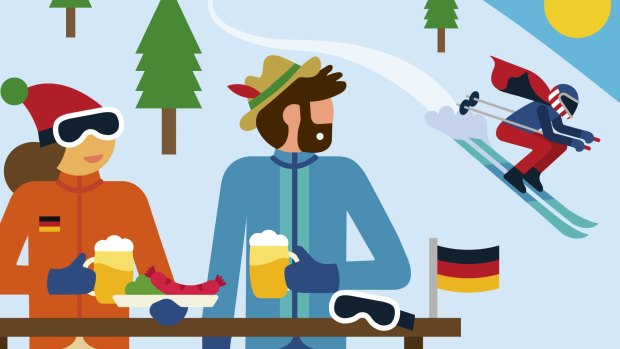This was published 1 year ago
Skiing Europe v North America: Which should you choose?

Illustration: Greg Straight
Generally speaking, the ski (and snowboard) conditions and apres-ski scenes in Europe and North America differ enough to merit consideration before you decide where to take your next alpine getaway.
For a start, the whole cultural approach to skiing differs. To Europeans, skiing isn't just about physical activity but also an occasion for relaxation, dining and socialising.
European skiers might spend only a few hours each day swishing down the slopes. In between, they'll be enjoying a lie-in, long lunches and sun-soaking on chalet terraces. Here's an inside tip: ski early or at lunchtime in Europe and you'll find fewer skiers getting in your way.
Europeans often finish early in the afternoon to save energy for vigorous apres-ski celebrations and nightclubbing. For apres-ski, Europe can't be beaten; only Whistler comes close in North America.
North Americans tend to think of skiing mainly in sporting terms. Expect competition for first tracks in fresh snow. Conversations revolve around the latest conquered double-diamond run or back-country plunge. Resort apps track the kilometres and vertical metres visitors have skied.
Ironically though, skiing in North America isn't as physically demanding or as difficult. Vertical drops (the height between the ski area base and its highest lifted point) seldom exceed 750 metres; only a few resorts such as Jackson Hole or Big Sky manage over 1200 metres.
Most ski resorts sit on rounded hills (albeit backed by impressive peaks) and lie below the tree line, so are sheltered from the wind. Slopes are meticulously groomed. Beginner and intermediate skiers will be very happy.
The vertical drop in the European Alps hits 1800 metres in places such as Cortina or Davos. Many runs are steep and well above the tree line, which also means they're colder and icier. Challenging chutes and powder bowls are relatively common.
However, off-piste skiing in Europe is restricted and usually for experts only. Heli-skiing is limited; in fact, it's banned in France and only allowed in the Arlberg in Austria. If you enjoy back-country skiing, then North America is a must, with far more options (even for intermediate skiers) and plenty of heli-skiing, often to overnight cabins. For champagne powder snow, Utah and Colorado are fabulous.
Be aware that most European ski resorts lie within striking distance of cities, which means long, sometimes rowdy lift queues and more crowded slopes (particularly on weekends) than in most North American counterparts, although Vail and Whistler are among exceptions. If you're a fast or nervous skier, you'll enjoy North America's uncrowded runs.
A benefit of proximity is that you can leaven your European ski holiday with visits to cities such as Innsbruck or Geneva. European resorts are often charming, as they're centred on original villages and have distinctive local architecture and culture, although France does have numerous purpose-built concrete resorts.
North America can put on history and charm – think Aspen or Telluride – but most of its resorts, many run by large corporations, lack flavour, even if their far friendlier service is a compensation. With the skiing world-class on both continents, why not give both a go?
Sign up for the Traveller newsletter
The latest travel news, tips and inspiration delivered to your inbox. Sign up now.